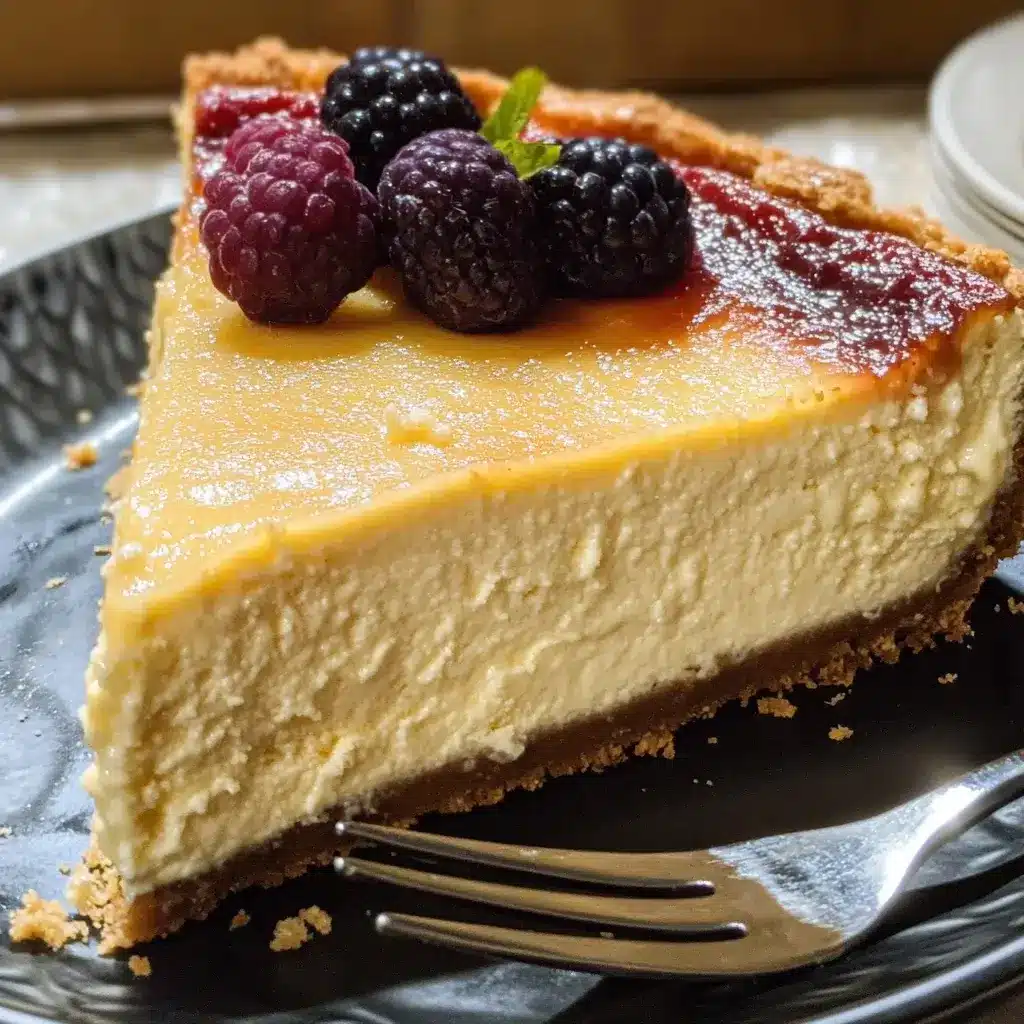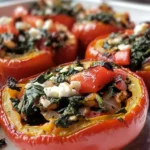It’s funny how some recipes just become instant classics in your household. This Creamy Italian Cheesecake? It’s one of those. From the first bite, my family was hooked. The texture is unbelievably smooth, the flavor is rich but not overly sweet, and that hint of citrus zest just elevates the whole experience. Forget dense, New York style cheesecake – this Italian version, with its ricotta base, is lighter, airier, and yet still incredibly satisfying. It’s become our go-to dessert for special occasions, and honestly, sometimes for just-because-it’s-Tuesday moments too. If you’re looking for a cheesecake that’s a little different, a little more refined, and guaranteed to impress, you absolutely have to try this Creamy Italian Cheesecake recipe. Trust me, your family (and your taste buds!) will thank you.
Ingredients for Creamy Italian Cheesecake
- Full-Fat Ricotta Cheese: (2 lbs) The heart of Italian cheesecake. Opt for whole milk ricotta for the creamiest texture and authentic flavor. Drained well to remove excess moisture.
- Cream Cheese: (8 oz, softened) Adds richness and tang, providing the classic cheesecake base. Ensure it’s softened for smooth blending.
- Granulated Sugar: (1 ½ cups) Sweetens the cheesecake to perfection. Adjust slightly to your sweetness preference.
- Large Eggs: (4) Bind the ingredients together and contribute to the cheesecake’s structure and richness. Use large eggs for consistent results.
- Egg Yolks: (2) Extra yolks enhance the richness and creaminess, creating a more decadent texture.
- Vanilla Extract: (2 teaspoons) Enhances the overall flavor profile, adding warmth and depth. Use pure vanilla extract for the best taste.
- Lemon Zest: (From 1 large lemon) Brightens the cheesecake with a refreshing citrus note, balancing the richness. Use fresh lemon zest for the most vibrant flavor.
- Orange Zest: (From ½ large orange) Adds a subtle sweetness and complexity to the citrus profile. Fresh orange zest complements the lemon beautifully.
- All-Purpose Flour: (¼ cup) Provides a slight binding agent, contributing to the cheesecake’s structure without making it dense.
- Pinch of Salt: Enhances the sweetness and balances the flavors. A small amount makes a big difference.
- Graham Cracker Crust (Optional): (For a traditional base) Store-bought or homemade graham cracker crust adds a classic textural contrast. Can be omitted for a crustless cheesecake.
Instructions: Baking Your Creamy Italian Cheesecake
- Prepare Your Oven and Baking Pan: Preheat your oven to 325°F (160°C). This lower temperature is crucial for baking a creamy cheesecake without cracks. Position a rack in the center of the oven. If using a springform pan, wrap the bottom and sides of the pan tightly with heavy-duty aluminum foil to prevent water from seeping in during the water bath. If you are not using a water bath, you can skip the foil wrapping, but a water bath is highly recommended for the creamiest texture.
- Make the Graham Cracker Crust (Optional): If you are using a graham cracker crust, prepare it now. You can use a pre-made crust or make your own by combining graham cracker crumbs, melted butter, and sugar. Press the mixture firmly into the bottom of your springform pan and slightly up the sides. Pre-bake the crust for 8-10 minutes at 325°F (160°C) and let it cool slightly before adding the filling. If you are making a crustless cheesecake, proceed to the next step.
- Drain the Ricotta Cheese: Place the ricotta cheese in a fine-mesh sieve lined with cheesecloth or paper towels. Set the sieve over a bowl and let it drain in the refrigerator for at least 30 minutes, or ideally for 1-2 hours. This step is essential to remove excess moisture from the ricotta, which will prevent your cheesecake from being watery and ensure a dense, creamy texture. Discard the drained liquid.
- Cream Together Cream Cheese and Sugar: In a large mixing bowl, using an electric mixer (stand mixer or hand mixer), beat the softened cream cheese and granulated sugar together until smooth and creamy. Beat on medium speed for about 2-3 minutes, scraping down the sides of the bowl as needed to ensure everything is evenly incorporated. The mixture should be light and fluffy, with no lumps of cream cheese remaining.
- Incorporate Ricotta Cheese: Add the drained ricotta cheese to the cream cheese mixture. Beat on low speed until just combined and smooth. Be careful not to overmix at this stage, as overmixing can incorporate too much air and lead to cracks in your cheesecake during baking. Mix just until the ricotta is fully incorporated and the batter is homogeneous.
- Add Eggs and Egg Yolks: Add the eggs one at a time, beating well after each addition until fully incorporated. Then, add the egg yolks one at a time, again mixing until just combined after each yolk. Continue to mix on low speed and avoid overmixing after adding the eggs and yolks.
- Flavor with Vanilla and Zests: Stir in the vanilla extract, lemon zest, and orange zest. Mix until evenly distributed throughout the batter. The citrus zests will add a bright and refreshing flavor to the cheesecake.
- Add Flour and Salt: Sprinkle the all-purpose flour and salt over the batter. Gently fold them in using a spatula or mix on the lowest speed until just combined. Be careful not to overmix at this stage; just ensure that the flour is fully incorporated and there are no streaks of flour remaining.
- Prepare the Water Bath (Recommended): Place the foil-wrapped springform pan inside a larger roasting pan. Carefully pour the cheesecake batter into the prepared pan, smoothing the top with a spatula. Heat water to boiling. Gently pour the boiling water into the roasting pan around the springform pan, filling it up to about halfway up the sides of the cheesecake pan. The water bath creates a humid environment in the oven, which helps the cheesecake bake evenly and prevents cracking.
- Bake the Cheesecake: Carefully transfer the roasting pan with the cheesecake and water bath to the preheated oven. Bake for 60-75 minutes, or until the cheesecake is set around the edges but still slightly jiggly in the center. The internal temperature should reach around 150-155°F (65-68°C). A slight jiggle in the center is okay; the cheesecake will continue to set as it cools.
- Cool Gradually in the Oven: Once baked, turn off the oven and crack the oven door slightly open. Let the cheesecake cool in the oven for 1 hour. This gradual cooling process is crucial to prevent cracks from forming on the surface of the cheesecake. Do not remove the cheesecake from the oven immediately.
- Cool Completely and Chill: Remove the cheesecake from the oven and water bath. Let it cool completely at room temperature on a wire rack. Once cooled to room temperature, cover the cheesecake with plastic wrap and refrigerate it for at least 6 hours, or preferably overnight. Chilling allows the cheesecake to fully set and develop its flavor and texture.
- Release and Serve: Before serving, carefully remove the sides of the springform pan. If desired, run a thin knife or offset spatula around the edge of the cheesecake before releasing the pan sides to ensure a clean release.
Nutrition Facts (Per Serving)
(Note: Nutritional information is an estimate and can vary based on specific ingredients and serving size.)
- Serving Size: 1 slice (based on 12 servings per cheesecake)
- Calories: Approximately 350-400 kcal
- Total Fat: 25-30g
Preparation Time
Prep Time: 30-40 minutes (includes ricotta draining time and ingredient preparation)
Bake Time: 60-75 minutes
Cooling Time: 1 hour in oven + 2-3 hours at room temperature
Chill Time: Minimum 6 hours (ideally overnight)
Total Time: Approximately 9-12 hours (including chilling)
While the total time seems long, most of it is inactive time for draining, baking, cooling, and chilling. Hands-on preparation is relatively straightforward and takes less than an hour.
How to Serve Your Creamy Italian Cheesecake
- Classic Slice: Simply cut a slice and enjoy it as is. The creamy texture and subtle citrus notes are delightful on their own.
- Fresh Berries: Top with a mix of fresh berries like strawberries, blueberries, raspberries, or blackberries. The tartness of the berries complements the richness of the cheesecake beautifully.
- Fruit Coulis: Drizzle with a homemade or store-bought fruit coulis (like raspberry or strawberry coulis) for added sweetness and flavor.
- Chocolate Shavings: Garnish with dark or milk chocolate shavings for a touch of decadence.
- Whipped Cream: Serve with a dollop of freshly whipped cream for extra creaminess and a lighter touch.
- Citrus Segments: Arrange segments of fresh oranges or mandarins around the cheesecake for a vibrant and refreshing presentation, enhancing the citrus notes in the cheesecake itself.
- Espresso or Coffee: Pair with a strong cup of espresso or coffee. The bitterness of the coffee balances the sweetness of the cheesecake perfectly.
- Sweet Wine: Serve alongside a dessert wine like Moscato d’Asti or Vin Santo for a sophisticated dessert pairing.
Additional Tips for Perfect Italian Cheesecake
- Use Full-Fat Ricotta and Cream Cheese: For the ultimate creamy texture, always use full-fat ricotta and cream cheese. Reduced-fat versions will not yield the same rich and decadent results.
- Drain Ricotta Thoroughly: Don’t skip the step of draining the ricotta cheese. Removing excess moisture is crucial for preventing a watery cheesecake and achieving a dense, creamy texture.
- Soften Cream Cheese Properly: Ensure your cream cheese is softened to room temperature before mixing. This will prevent lumps and ensure a smooth batter.
- Don’t Overmix: Overmixing the batter, especially after adding eggs, can incorporate too much air, which can lead to cracks on the surface of the cheesecake during baking. Mix just until ingredients are combined.
- Use a Water Bath: Baking the cheesecake in a water bath is highly recommended for even baking and preventing cracks. The gentle, humid heat helps the cheesecake cook uniformly and prevents the top from drying out and cracking.
- Cool Gradually: Cooling the cheesecake slowly, first in the oven with the door ajar and then at room temperature, is essential to prevent cracking. Rapid temperature changes can cause the cheesecake to contract too quickly and crack.
- Chill for Long Enough: Allow the cheesecake to chill in the refrigerator for at least 6 hours, or preferably overnight. This chilling period is necessary for the cheesecake to fully set and for the flavors to meld together.
- Zest Fresh Citrus: Use freshly grated lemon and orange zest for the most vibrant and aromatic flavor. Avoid using bottled lemon or orange juice as a substitute for zest, as it won’t provide the same depth of flavor.
Frequently Asked Questions (FAQ) About Creamy Italian Cheesecake
Q1: Can I make this cheesecake ahead of time?
A: Absolutely! In fact, it’s recommended to make this cheesecake at least a day ahead of time. It needs to chill for several hours to set properly, and the flavors actually improve overnight. It can be stored in the refrigerator for up to 3-4 days.
Q2: Can I freeze Italian Cheesecake?
A: Yes, Italian Cheesecake freezes quite well. To freeze, ensure the cheesecake is completely cooled and chilled. Wrap it tightly in plastic wrap, and then wrap it again in aluminum foil. Freeze for up to 2-3 months. Thaw overnight in the refrigerator before serving.
Q3: My cheesecake cracked! What did I do wrong?
A: Cheesecake cracking is a common issue. Possible causes include baking at too high a temperature, overbaking, or rapid temperature changes during cooling. Using a water bath and cooling the cheesecake gradually in the oven are key steps to prevent cracking. Also, avoid overmixing the batter.
Q4: Can I make this cheesecake crustless?
A: Yes, this recipe is delicious even without a crust! Simply skip the graham cracker crust step and pour the batter directly into the prepared springform pan. Baking time may be slightly shorter for a crustless cheesecake, so keep an eye on it.
Q5: Can I use low-fat ricotta or cream cheese?
A: While you can, it’s not recommended for the best results. Full-fat ricotta and cream cheese are crucial for the creamy texture and rich flavor of Italian Cheesecake. Using low-fat versions may result in a drier and less flavorful cheesecake.
Q6: Can I add other flavors to this cheesecake?
A: Yes, you can customize the flavor! Consider adding a teaspoon of almond extract instead of vanilla, or incorporating different citrus zests like lime or grapefruit. You could also swirl in some fruit puree (like raspberry or strawberry) before baking for a marbled effect.
Q7: Do I really need a springform pan?
A: While a springform pan is highly recommended for easy removal and presentation, you can bake this cheesecake in a regular cake pan. If using a regular pan, line it with parchment paper, leaving an overhang to help lift the cheesecake out after baking and chilling. You might have to be more careful when removing the cheesecake from a regular pan.
Q8: What if I don’t have time to make a water bath? Is it essential?
A: While not strictly essential, a water bath is highly recommended for the creamiest texture and to minimize cracking. If you skip the water bath, bake at the same temperature but keep a very close eye on the cheesecake and reduce baking time slightly if needed. The texture might be slightly less creamy and the risk of cracking is higher without a water bath.

Creamy Italian Cheesecake
Ingredients
- Full-Fat Ricotta Cheese: (2 lbs) The heart of Italian cheesecake. Opt for whole milk ricotta for the creamiest texture and authentic flavor. Drained well to remove excess moisture.
- Cream Cheese: (8 oz, softened) Adds richness and tang, providing the classic cheesecake base. Ensure it’s softened for smooth blending.
- Granulated Sugar: (1 ½ cups) Sweetens the cheesecake to perfection. Adjust slightly to your sweetness preference.
- Large Eggs: (4) Bind the ingredients together and contribute to the cheesecake’s structure and richness. Use large eggs for consistent results.
- Egg Yolks: (2) Extra yolks enhance the richness and creaminess, creating a more decadent texture.
- Vanilla Extract: (2 teaspoons) Enhances the overall flavor profile, adding warmth and depth. Use pure vanilla extract for the best taste.
- Lemon Zest: (From 1 large lemon) Brightens the cheesecake with a refreshing citrus note, balancing the richness. Use fresh lemon zest for the most vibrant flavor.
- Orange Zest: (From ½ large orange) Adds a subtle sweetness and complexity to the citrus profile. Fresh orange zest complements the lemon beautifully.
- All-Purpose Flour: (¼ cup) Provides a slight binding agent, contributing to the cheesecake’s structure without making it dense.
- Pinch of Salt: Enhances the sweetness and balances the flavors. A small amount makes a big difference.
- Graham Cracker Crust (Optional): (For a traditional base) Store-bought or homemade graham cracker crust adds a classic textural contrast. Can be omitted for a crustless cheesecake.
Instructions
- Prepare Your Oven and Baking Pan: Preheat your oven to 325°F (160°C). This lower temperature is crucial for baking a creamy cheesecake without cracks. Position a rack in the center of the oven. If using a springform pan, wrap the bottom and sides of the pan tightly with heavy-duty aluminum foil to prevent water from seeping in during the water bath. If you are not using a water bath, you can skip the foil wrapping, but a water bath is highly recommended for the creamiest texture.
- Make the Graham Cracker Crust (Optional): If you are using a graham cracker crust, prepare it now. You can use a pre-made crust or make your own by combining graham cracker crumbs, melted butter, and sugar. Press the mixture firmly into the bottom of your springform pan and slightly up the sides. Pre-bake the crust for 8-10 minutes at 325°F (160°C) and let it cool slightly before adding the filling. If you are making a crustless cheesecake, proceed to the next step.
- Drain the Ricotta Cheese: Place the ricotta cheese in a fine-mesh sieve lined with cheesecloth or paper towels. Set the sieve over a bowl and let it drain in the refrigerator for at least 30 minutes, or ideally for 1-2 hours. This step is essential to remove excess moisture from the ricotta, which will prevent your cheesecake from being watery and ensure a dense, creamy texture. Discard the drained liquid.
- Cream Together Cream Cheese and Sugar: In a large mixing bowl, using an electric mixer (stand mixer or hand mixer), beat the softened cream cheese and granulated sugar together until smooth and creamy. Beat on medium speed for about 2-3 minutes, scraping down the sides of the bowl as needed to ensure everything is evenly incorporated. The mixture should be light and fluffy, with no lumps of cream cheese remaining.
- Incorporate Ricotta Cheese: Add the drained ricotta cheese to the cream cheese mixture. Beat on low speed until just combined and smooth. Be careful not to overmix at this stage, as overmixing can incorporate too much air and lead to cracks in your cheesecake during baking. Mix just until the ricotta is fully incorporated and the batter is homogeneous.
- Add Eggs and Egg Yolks: Add the eggs one at a time, beating well after each addition until fully incorporated. Then, add the egg yolks one at a time, again mixing until just combined after each yolk. Continue to mix on low speed and avoid overmixing after adding the eggs and yolks.
- Flavor with Vanilla and Zests: Stir in the vanilla extract, lemon zest, and orange zest. Mix until evenly distributed throughout the batter. The citrus zests will add a bright and refreshing flavor to the cheesecake.
- Add Flour and Salt: Sprinkle the all-purpose flour and salt over the batter. Gently fold them in using a spatula or mix on the lowest speed until just combined. Be careful not to overmix at this stage; just ensure that the flour is fully incorporated and there are no streaks of flour remaining.
- Prepare the Water Bath (Recommended): Place the foil-wrapped springform pan inside a larger roasting pan. Carefully pour the cheesecake batter into the prepared pan, smoothing the top with a spatula. Heat water to boiling. Gently pour the boiling water into the roasting pan around the springform pan, filling it up to about halfway up the sides of the cheesecake pan. The water bath creates a humid environment in the oven, which helps the cheesecake bake evenly and prevents cracking.
- Bake the Cheesecake: Carefully transfer the roasting pan with the cheesecake and water bath to the preheated oven. Bake for 60-75 minutes, or until the cheesecake is set around the edges but still slightly jiggly in the center. The internal temperature should reach around 150-155°F (65-68°C). A slight jiggle in the center is okay; the cheesecake will continue to set as it cools.
- Cool Gradually in the Oven: Once baked, turn off the oven and crack the oven door slightly open. Let the cheesecake cool in the oven for 1 hour. This gradual cooling process is crucial to prevent cracks from forming on the surface of the cheesecake. Do not remove the cheesecake from the oven immediately.
- Cool Completely and Chill: Remove the cheesecake from the oven and water bath. Let it cool completely at room temperature on a wire rack. Once cooled to room temperature, cover the cheesecake with plastic wrap and refrigerate it for at least 6 hours, or preferably overnight. Chilling allows the cheesecake to fully set and develop its flavor and texture.
- Release and Serve: Before serving, carefully remove the sides of the springform pan. If desired, run a thin knife or offset spatula around the edge of the cheesecake before releasing the pan sides to ensure a clean release.
Nutrition
- Serving Size: one normal portion
- Calories: 400
- Fat: 30g






